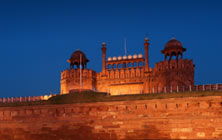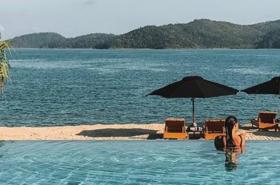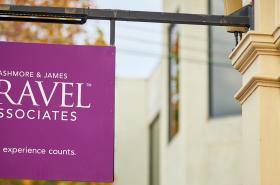Earlier this year, Catherine Baker from Press & James Travel Associates discovered 'The Golden Triangle' - made up of the three historic cities of Jaipur, Agra and Delhi.
Our journey started in Jaipir, the Pink City in the state of Rajasthan, North West India. We stayed at the lovely Trident Hotel which is across the road from Jaipur's lake palace and surrounded by the Arawali hills, famous for it's rich source of gems. From there we explored the well preserved and quite ornate Amber Fortress Palace which was the ancient capital of the Rajpts from the 12th Century until the 18th Century when Jaipur was founded. You can even take an elephant ride to the Palace. Probably the most photographed building in Jaipur is "The Palace of Winds" which is actually a facade the royal women used to peep out of to see the city and passing processions. There are 953 windows and niches intricately carved and decorated.
Astronomy and astrology are important in every day Indian life. Many people will have astrological charts drawn up to determine auspicious dates for important life events to take place or suitable marrying partners. The Jantar Mantar Observatory built in the 1700's in Jaipur is a collection of 14 architectural astronomical instruments for measuring time, predicting eclipses and other celestial events. The highest stands 27 metres high. You will marvel at the accuracy the "clock" in particular.
A visit to the City Palace and it's museum shows you the grandeur the ruling family of Jaipur used to live in.
If you are looking for a 5-star luxury hotel in Jaipur, then I'd recommend the lovely Oberoi Taj Villas where they pride themselves on attention to detail. The hotel is a 30 min drive from the centre of Jaipur and you can have a room, luxury tent or villa set in a 32 hectare garden, recreating the romance of Rajasthan.
From Jaipur we drove to Bharatapur where we stayed in the lovely and quaint Birders Inn. It is a stone's throw from Keoladeo Ghana National Park which has been recognised by UNESCO as a World Heritage site. The park is a thriving freshwater marsh system which attracts a large and diverse population of migratory birds. We viewed the birds, deer, turtles and monkeys from our rickshaw and on our walks through the park.
On the way to Agra we stopped at the well preserved Mughal City of Fatehpur Skiri also a UNESCO World Heritage site. It was built by the great Mughal Emperor Akbar. After the death of his twin boys, Akbar consulted a Sufi Saint in Sikri who predicted Akbar would bear more sons. The prediction came true and he had a son born in Sikri. He named his son after the saint and built a palace and royal city in Sikri. For unknown reasons the city was abandoned after 10 years.
The traffic in India is something to behold. We drove on well maintained roads, lined by eucalyptus trees, and passed camels being herded along the road, auto rickshaws with ladies in bright coloured saris, bicycles loaded high with all manner of goods, motor bikes and colourful Tata and Mahindra trucks decorated with paintings of Hindu deities and tinsel. The cacophony of horns was almost constant with a variety of tunes ringing out!
Our arrival in Agra was thwarted when we came across a mob of demonstrating lawyers, distinctive in their white shirts and black ties, who blocked the street while yelling to have something done about their concerns. We managed to turn the bus around and find another way into the city and drove up to the Agra Fort also known as the Red Fort. Most of the country was governed from this fort and it is quite grand and palatial. Akbar's son, Shah Jahan who built the Taj Mahal for his wife, was imprisoned in Agra Fort at the end of his life by his son. He was kept in a section of the Fort which had a view of the Taj Mahal and it was from there I glimpsed my first view of the legendary Taj Mahal.
We visited the Taj Mahal later that day for sunset. Talk about stunning! It is a truly inspiring building - a monument to love built by Shah Jahan for his wife Mumtaz Mahal who died giving birth to their 14th child. Seeing the structure up close and the detailed intricate marble inlay work was wonderful, and hearing about the nuances of architecture and design work which went into this monument was fascinating. The colours of the sunset cast a lovely soft light on the Taj Mahal. It was a lovely time to day to visit.
From Agra we drove to Delhi. The volume of traffic built up gradually as we neared Delhi. Delhi is a contrast of modern buildings and hotels, and older colonial style buildings. They are working frantically to complete the Delhi Metro and all the venues for the Commonwealth Games to be held there in 2010.
We took a tour of Old Delhi and the small laneways crowded with lots of shops selling just about anything you could ever want. We visited the largest Mosque in India and saw Delhi Fort. Ghandi's mausoleum is a very important shrine so you'll meet people from all over India on their pilgrimage there. The buildings in New Delhi were designed by the British and are situated along grand and wide boulevards. We went past the 42 metre high India Gate which is the National Monument of India. Our time in Delhi was short, but we managed to go shopping at the Dilli Haat market where artisans from all over India come to sell their wares. There was a great range of items and the quality was excellent.
There are some lovely hotels in New Delhi. We stayed at Svelte Suites where you can self cater if you desire. It is located in South Delhi and has the latest mod cons for an international standard hotel. It is adjacent to a modern shopping centre so you can If you want a modern 5* hotel, Le Meridien would suit you. It is the ultimate in modern luxury. Their lunch buffet is a work of art, especially the desserts! If you would prefer something older in style, then you can't go past the 5-star Imperial Hotel. It is my favourite. The hotel is grand with impeccable decor, high ceilings and an amazing array of art work and colonial furniture. It is the ultimate in luxury and personal service.
One of the joys of travelling is experiencing the food and Indian food is full of flavour and variety. Food in India uses spices which have medicinal, seasonal and preservative benefits. If you have a chance to do a cooking course, you will learn about the Ayurvedic benefits of various spices and which give you the authentic flavour you taste in authentic Indian cooking. The food is so good you'll probably end up putting on weight when travelling in India!
India is a country of contrasts. There is a variety of landscapes, wildlife, people and religions. There are modern hotels which are superb and offer the best in terms of quality but then you'll see desperate poverty in the streets. India is a country where you will experience it all.
India truly is an amazing country. There is a huge variety of sights, tastes and smells and all your senses are engaged on a trip to India. It is a diverse country and you can go on game drives to see wildlife including lions and tigers, visit ancient temples and cities and marvel at the architecture, explore modern cities, shop up a storm in local markets, relax in luxury hotels which were once forts and palaces, trek in the Himalayan mountains, take a camel ride through the desert, visit holy cities and important religious pilgrimage suites or cruise down the quiet back waters of the south. There is something for everyone!













